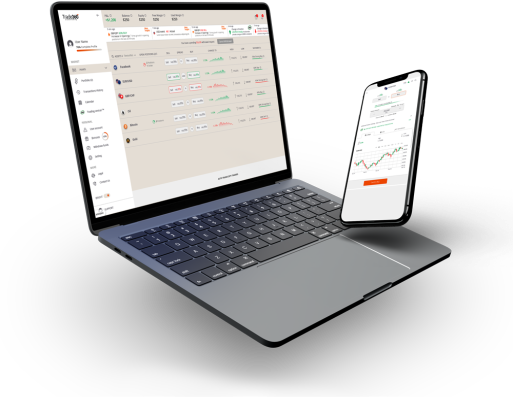What is Leverage?
Leverage increases your trading capacity and multiplies your investment power. Increase your profit, but also your risk.
Register Now
Understanding Leverage
When online derivatives trading first appeared, the most popular underlying asset was Forex – speculating on the relative values of foreign currency pairs. Entailing all transactions involving the exchange of foreign currencies, this market is huge, and consequently, exchange rates change by very small increments – measured usually in hundredths of a cent, or ‘pips’. In the case of the Euro-US Dollar pair, for example, the average daily change has been between 40 to 100 pips (0.4 – 1 cent per day, up or down) for the past 10 years.
Consequently, one would need to invest huge amounts in a trading position in order to see any discernible change – much more than the average retail trader has at his/her disposal. As a result, online brokers offer their clients the possibility of leveraging their investment. Unfortunately, many traders who USE leverage do not really understand what it is.
The term ‘leverage’, meaning ‘increasing’, was first used during the industrial revolution to describe the increasing scope of an action using a physical lever. In 1933, the word entered the business world to denote the expansion of a business by mortgaging its assets for a loan. And so, to understand what is leverage in financial trading, one merely needs to consider that it entails mortgaging your funds to invest in an instrument. There need be no direct relationship between what you mortgage and the size of the investment – in fact, most online brokers will open a position worth much more than your mortgaged assets; however, your profits and losses are related to the investment and not the original sum (see ‘margin’ below) that has been mortgaged.
The level of increase is depicted as the ratio between the trader’s (margin) investment and the size of the position the broker consequently opens. 400:1 leverage means that for every dollar invested, the position opened equals $400. 20:1 leverage means that for every dollar, the position size equals $20, and so on.

The Flip-Side of Leverage – Margin

When trading with an online CFDs broker, money is not deducted from your account when you open a position. Instead, only when you close the position will profit be added or losses subtracted from your balance.
Meanwhile, your money will be divided into used and free margin. Used margin is the amount of your money that is mortgaged to your open positions and free margin is money you can still use to open new positions.
A third type of margin is required margin – the amount of free margin you must have to open a specific new position. Required margin is calculated by a position size and your leverage, and it is quoted as a percentage that is inversely proportioned to the leverage on an instrument. Thus, if you are opening a €10,000 position (1 mini lot) on the EURUSD with 400:1 leverage, you will be required to mortgage 1/400 (0.0025%) of the position size – €25 required margin.
The moment the position is opened, the required margin is added to your used margin and subtracted from your free margin. Since most positions are opened at a loss due to the broker’s bid/ask spread (the difference between the sell and buy rates offered), that loss (which is already leveraged) is also deducted from the free margin and added to your used margin. This dynamic continues for as long as the position accrues losses or profits – it is always in flux to the tune of your leveraged position size.
Where’s the problem?
Leverage – as explained above – affects, not only the position size but also the trader’s subsequent profit or loss on a position.
If a trader invests $1 in a position, a 100-pip movement in the currency-pair’s value – 1 cent, in the case of the EURUSD pair, for example – translates into a $4 movement in the case of 400:1 leverage. Where this is profit, clearly there is no problem; where it is a loss, the trader has lost 4 times his/her investment, which could come as a sobering surprise, considering that most brokers’ minimum forex position equals 10,000 units, or €10,000, for the EURUSD pair.
Now, consider that, with 400:1 leverage, the trader’s investment equals the equivalent of (10000/400=) €25, discovering a €100 loss on what seems to be a 1-cent movement can be quite disconcerting!

Control your Leverage with Self-Select

Until now, leverage was pre-selected by your broker, based on the level of your trading status. Retail traders received anywhere between 2:1 and 30:1 leverage – depending on the asset class and instrument, while professional traders could get anything up to 400:1, considering that their required experience and resources could afford them that level of risk.
Lowering your leverage entailed contacting your account manager and having him/her change your leverage per-account. Now, with the technological barrier finally broken, we can finally enable traders to determine their leverage and risk level for each and every separate trade. It’s simply a matter of making your selection by a single click and confirming the position.
Remember, though, that once your position has been opened, you can no longer change that parameter, since your margin levels (used and free) are already in flux.



